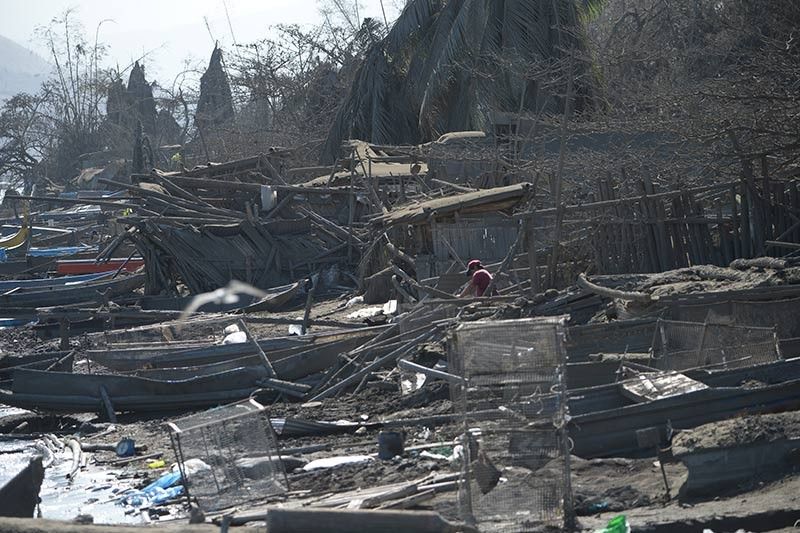Taal eruption steals livelihoods

AMADEO, Cavite — Decimated fish, scarred coffee plants and vanished tourists: the Taal volcano eruption in the Philippines has inflicted significant damage on the livelihoods of tens of thousands and is expected to cause more.
When Taal exploded to life Sunday it spewed towering columns of fine grey ash, which officials said destroyed crops and killed off potentially tonnes of fish raised in the lake that rings the volcano.
"We lost a lot of money because all our fish are gone," said Cesario Rodriguez, 34, a fish farmer. "We just need to find a way to survive."
It didn't help either when government health officials warned people not to eat the fish as it could have been contaminated with volcanic sulphur, though the nation's health agency told AFP no formal ban is in place.
The warning of a further, potentially catastrophic eruption, also led authorities to urge the thriving tourism industry near the volcano — a popular attraction — to suspend activity as a precaution.
The nation's seismological agency has issued its second-highest alert, saying Taal could unleash an "explosive eruption" at any time.
With scores of bookings canceled and many restaurants and hotels shuttered, the eruption will hurt, but no one knows how much yet.
"It going to be negative... 90 percent of the tourism establishments in Tagaytay are closed," said Elinia Sanggalang, a local tourism official, referring to the resort town with stunning views of the volcano.
'We're still lost'
The town alone draws about 5.5 million tourists per year, in part because it is a mere 60 kilometres (37 miles) south of the hot and crowded capital Manila.
Estimates of the harm to farmers and fishermen are already coming in to focus, and authorities say the amount could grow.
The agriculture agency said Friday it estimates so far the volcano caused about $59 million in damage to the industry, which is just about 4% of what the region produced in 2017.
In the Philippines, life is already hard for those who have not benefitted from the nation's rapid growth in the past decade. Millions still live on less than $2 a day.
However, the pain for some, like coffee growers, will take years before it can be fully calculated.
That's because it takes about two years for coffee plants to mature and begin bearing fruit, said Arnold Bay, an official with a cooperative of about 150 small growers.
There are already signs their plants were heavily damaged, though they hope to still harvest some of their crop.
"It will be difficult for us and for our clients," said Bay. "It will take two years for the farmers to have their livelihood back."
The process of recovering is far from started, especially for the over 60,000 people forced out of homes near the volcano and into evacuation centres.
They can't go home while the threat of a new, powerful eruption remains, so they will live in limbo for now.
"We don't know what to do next," Dandy Belencio, 43, a fish vendor whose home was destroyed in the eruption.
"We're still lost on what will happen to us," he told AFP.
Get updates as Phivolcs issues warnings over activity in Taal Volcano. (Main photo by Philstar.com/Rosette Adel)
The Philippine Institute of Volcanology and Seismology issues a notice reporting an increased and continuous degassing activity from Taal Volcano.
In its 6 p.m. advisory, Phivolcs says the sulfur dioxide emission from the main crater reached 9762 tonnes per day. This was the higher recorded this year.
Phivolcs adds that there was no smog or vog observed. — Rosette Adel
The Philippine Institute of Volcanology and Seismology says Taal Volcano is still under Alert Level 1.
In an update on Wednesday, its says that the daily sulfur dioxide emissions (SO2) reached 2887 tonnes / day (06 October 2023).
Phivolcs also observes upwelling of hot volcanic fluids in the Main Crater Lake. — Rosette Adel
The Philippine Institute of Volcanology and Seismology reports that Taal Volcano's daily sulfur dioxide emissions (SO2) reached 2887 tonnes.
It observes upwelling of hot volcanic fluids in the Main Crater Lake as well as volcanic smog or vog.
The volcano's emissions are also 2400 meters tall. — Rosette Adel
The Philippine Institute of Volcanology and Seismology releases time-lapse snapshots of degassing activity from the Taal Main Crater and volcanic smog or vog formation on Sunday.
These were taken from 5:45 a.m. to 11:42 a.m. by the Mt. Macolot, Cuenca, Batangas station (VTCU) IP Camera.
LOOK: Time-lapse snapshots of degassing activity from the Taal Main Crater and volcanic smog or vog formation taken from 05:45 AM to 11:42 AM today, 8 October 2023 by the Mt. Macolot, Cuenca, Batangas station (VTCU) IP Camera. pic.twitter.com/jp48R1IZQy
— PHIVOLCS-DOST (@phivolcs_dost) October 8, 2023
— Rosette Adel
The Philippine Institute of Volcanology and Seismology records daily sulfur dioxide emissions that reached 2730 tonnes / day (22 September 2023).
It also observes upwelling of hot volcanic fluids in the Main Crater Lake and observed VOG.
Phivolcs adds that there is a ong-term deflation of the Taal Caldera; short-term inflation of the northern flanks of the Taal Volcano Island.
- Latest
- Trending



































